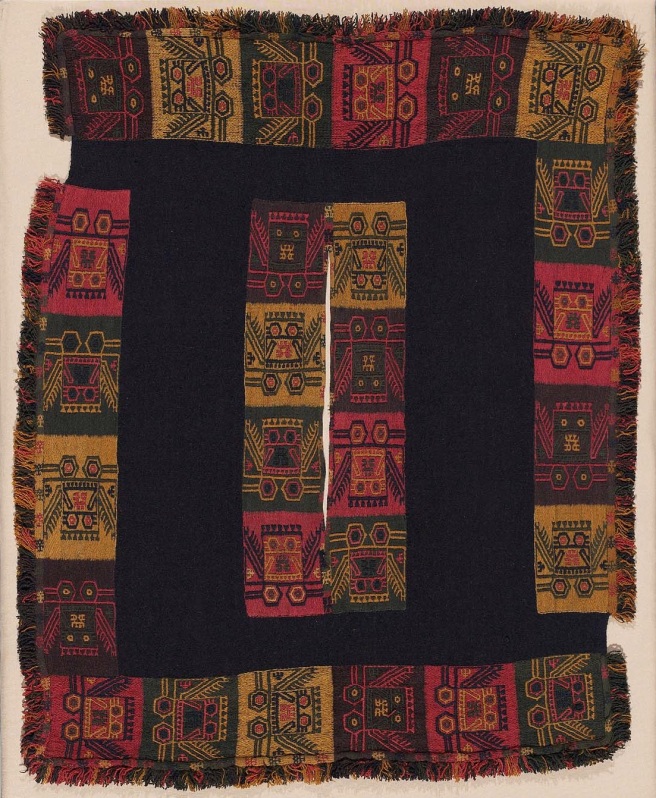
This small poncho, dating to 100 B.C.-0, would have covered the upper torso of its wearer and is executed in linear style embroidery, one of three distinct styles characterizing Paracas textiles (the other two being block color and broad line style). Despite having been made over 2,000 years ago, this textile appears vibrant, brand new, and absolutely intact – its pristine condition given its age is nothing short of astonishing.
Two L-shaped borders along the outer edge and two vertical borders on either side of the neck slit contain squares of varying colors that encase a double-headed bird motif. Nesting within each double-headed bird is an inversion of this figure, within which a third, smaller, upright variant rests in a type of telescopic layering. The bird, reduced to its barest of elements of detail, is further embroidered within the wings of the outer figure, and along the finished edges of the neck slit and fabric edge. Directional orientation of the border compositions run clockwise (outer borders and fabric edge) and counter-clockwise (inner border and neck slit).
My visual observations of this textile led me to wonder about two gaps in the embroidery that appear on either end of the L-shaped borders. This design choice is addressed in a paper by the late Anne Paul, The Multiple Layers of Meaning in a Paracas Necropolis Textile (2000), as part of her analysis of a poncho in the collections of the Art Institute of Chicago. (See Textile Society of America Symposium Proceedings. 827. Pages 210-211). Here, Paul proposes that visual content and style in Paracas textiles shown to be consistent over many years bears intentionality and symbolic importance, and carries forward the illuminating research of Mary Frame, who first suggested that visual elements in early Paracas textiles are the very embodiment of textile structure, drilling down to the direction and movement of plied spun fiber.
Terms that denote the directional twist of fibers are “S” and “Z”: to produce an “S” twist yarn, the fibers are spun in a clockwise direction; to produce a “Z” twist yarn they are spun counter-clockwise. This terminology extends to directional plying as well (two spun fibers twisted together). According to Paul, Paracas Necropolis textiles were typically Z spun, and S plied. If one were to imagine plied spun fibers, one strand would be visible in front, and the other strand hidden behind it. Paul goes on to assert that the ‘breaking points’ of the underlying strands – the points at which the strand goes under, and emerges up from, the overlying strand – are equivalent to the gaps in the poncho borders, signifying two twisting strands. In her conclusion, Paul invites us to imagine the donning of this ritual garment by its wearer:
…when the poncho was pulled over his head, this individual became caught between two twisting strands (the exterior borders) with immaterial circuits moving in opposite directions around his neck (figural orientation in exterior and interior borders).
Click for description, detail view and collection data on mfa.org
Objects in Brief is a randomized showcase of the MFA, Boston’s encyclopedic Textile and Fashion Arts collections. A featured object is indicative of the author’s curiosity and chosen so she may learn about its material and structural properties, function, history, and greater story. These “quick studies” have led to more in-depth explorations posted in A Closer Look.
